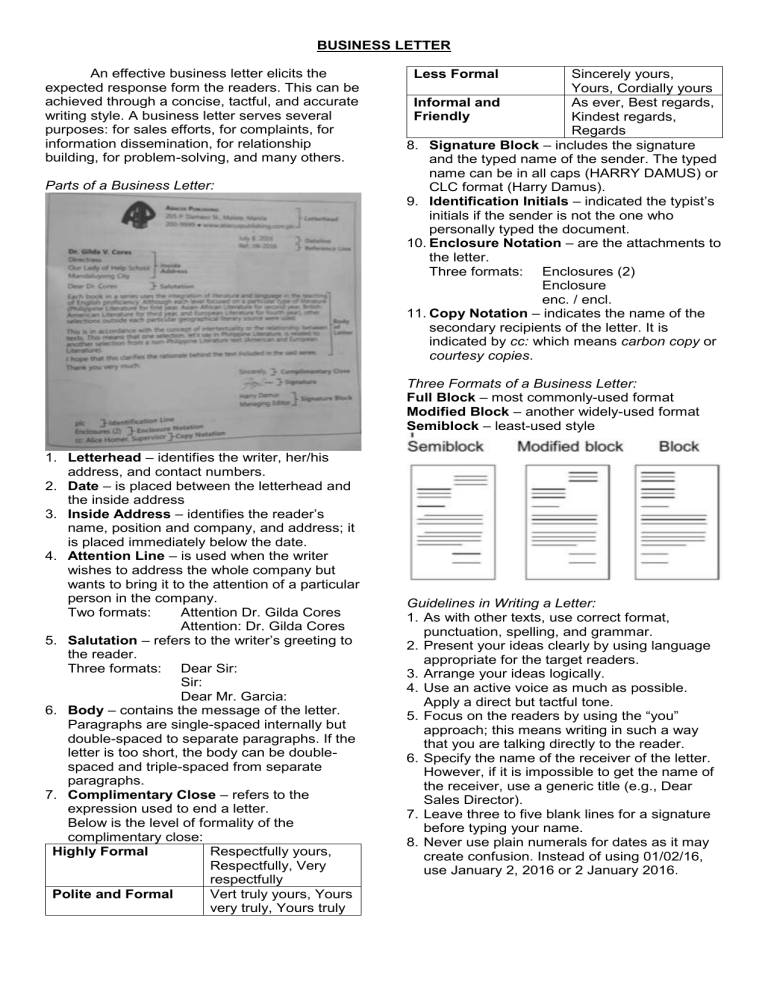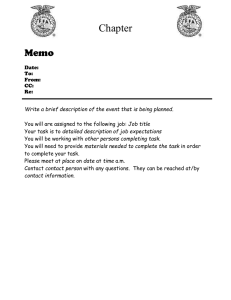
BUSINESS LETTER An effective business letter elicits the expected response form the readers. This can be achieved through a concise, tactful, and accurate writing style. A business letter serves several purposes: for sales efforts, for complaints, for information dissemination, for relationship building, for problem-solving, and many others. Parts of a Business Letter: Less Formal Sincerely yours, Yours, Cordially yours Informal and As ever, Best regards, Friendly Kindest regards, Regards 8. Signature Block – includes the signature and the typed name of the sender. The typed name can be in all caps (HARRY DAMUS) or CLC format (Harry Damus). 9. Identification Initials – indicated the typist’s initials if the sender is not the one who personally typed the document. 10. Enclosure Notation – are the attachments to the letter. Three formats: Enclosures (2) Enclosure enc. / encl. 11. Copy Notation – indicates the name of the secondary recipients of the letter. It is indicated by cc: which means carbon copy or courtesy copies. Three Formats of a Business Letter: Full Block – most commonly-used format Modified Block – another widely-used format Semiblock – least-used style 1. Letterhead – identifies the writer, her/his address, and contact numbers. 2. Date – is placed between the letterhead and the inside address 3. Inside Address – identifies the reader’s name, position and company, and address; it is placed immediately below the date. 4. Attention Line – is used when the writer wishes to address the whole company but wants to bring it to the attention of a particular person in the company. Two formats: Attention Dr. Gilda Cores Attention: Dr. Gilda Cores 5. Salutation – refers to the writer’s greeting to the reader. Three formats: Dear Sir: Sir: Dear Mr. Garcia: 6. Body – contains the message of the letter. Paragraphs are single-spaced internally but double-spaced to separate paragraphs. If the letter is too short, the body can be doublespaced and triple-spaced from separate paragraphs. 7. Complimentary Close – refers to the expression used to end a letter. Below is the level of formality of the complimentary close: Highly Formal Respectfully yours, Respectfully, Very respectfully Polite and Formal Vert truly yours, Yours very truly, Yours truly Guidelines in Writing a Letter: 1. As with other texts, use correct format, punctuation, spelling, and grammar. 2. Present your ideas clearly by using language appropriate for the target readers. 3. Arrange your ideas logically. 4. Use an active voice as much as possible. Apply a direct but tactful tone. 5. Focus on the readers by using the “you” approach; this means writing in such a way that you are talking directly to the reader. 6. Specify the name of the receiver of the letter. However, if it is impossible to get the name of the receiver, use a generic title (e.g., Dear Sales Director). 7. Leave three to five blank lines for a signature before typing your name. 8. Never use plain numerals for dates as it may create confusion. Instead of using 01/02/16, use January 2, 2016 or 2 January 2016. MEMORANDUM or MEMO Memorandum come form the Latin term memorare which means “to remember.” A memorandum, which is commonly shortened to “memo,” is meant to inform as well as to persuade people within an organization. It follows an inverted pyramid structure which means that the most important information comes first. Advantages of Using a Memo: 1. It reaches a large number of readers at the same time. 2. It serves as a written record that can be accessed any time. 3. It allows a detailed and accurate delivery of the message. Parts of a Memo: 1. LETTERHEAD – identifies the company, address, and contact numbers. 2. DATELINE – serves as a chronological record for reference purposes. 3. TO LINE – indicates the name and title of the receiver. 4. ATTENTION LINE – is used when the writer wishes to address the whole company but wants to bring it to the attention of a particular person in the company. Two formats: Attention Dr. Gilda Cores Attention: Dr. Gilda Cores 5. FROM LINE – indicates the name of the sender. The sender should affix his initials on the right side of his/her name for verification purposes. 6. SUBJECT LINE – announces the main content or topic of the memo. Subject is more preferred than the old term Re. 7. BODY – contains the message of the memo. Paragraphs are single-spaced internally but double-spaced to separate paragraphs. If the memo is very short, the body can be doublespaced and triple spaced to separate paragraphs. Paragraphs in the memo are not intended. When discussing a number of subtopics, a topic heading may be used so that the readers can quickly locate information. Never indent the first line of each paragraph. If the memo exceeds one page, begin the following page with recipient’s name, date, and page number, which are placed three lines from the top of the page. For example: Mr. Roxas, July 14, 2016, page 2. 8. IDENTIFICATION INITIALS – indicates the typist’s initials if the sender is not the one who personally typed the document. 9. ENCLOSURE NOTATION – are the attachments to the memo. It can be written in the following formats: Enclosures (2) Enclosure enc. / encl. 10. COPY NOTATION – indicates the name of the secondary recipients of the letter. It is indicated by cc: which means carbon copy or courtesy copies. Guidelines in Writing a Memo: 1. Use the correct format and standard use of language. 2. Use a bullet or numbered list to enumerate information. 3. Use a positive tone and concise wording, as well as active verbs. 4. Use headings to highlight topics. 5. Check for and remove grammatical and typographical errors. 6. Sign beside your typed name (sender). 7. Flush left the To, From, Date, and Subject lines. 8. Conclude the memo simply by saying Thank You or a directive action (e.g., For your compliance, For your immediate action). 9. Never use plain numerals for date as it may create confusion. Instead of using 01/02/17, use January 2, 2017 or 2 January 2017. Five Types of Memo: 1. Instruction Memo – provides the information needed by the readers to accurately perform directions Ex. a memo which directs employees how to have their annual checkup at the company clinic 2. Request Memo – asks readers to provide certain information or take certain actions Ex. a memo which requests for a fund seminar 3. Announcement Memo – provides information about an event, person, or thing Ex. a memo which announces the arrival of a new employee 4. Transmittal Memo – serves as a cover note for a more formal or lengthy document Ex. a memo wherein the sender is transmitting an annual report to the board of directors 5. Authorization Memo – gives permission Ex. a memo when an employee is allowed to have a different schedule so she may study on Saturdays

